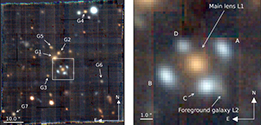As the light from a distant galaxy travels toward us, it sometimes encounters a region of spacetime warped by a massive galaxy in its path. If the alignment between the foreground galaxy and the background galaxy is just right, we’re treated to a spectacular sight: multiple images of the background galaxy arrayed around the foreground galaxy — a phenomenon called gravitational lensing. If the foreground galaxy is elliptical, the images of the background galaxy form a cross known as an Einstein Cross, as is the case with a system newly confirmed by Aleksandar Cikota (Gemini Observatory/NSF’s NOIRLab) and collaborators. To confirm the gravitationally lensed nature of the system, the team demonstrated via spectroscopy that the four images were of the same galaxy. The golden central galaxy is an elliptical behemoth whose light has been traveling to us for nearly 6 billion years, while the lensed starburst galaxy is far more distant, giving us a glimpse of when the universe was just 18.5% of its current age. To learn more about this new addition to the short list of known Einstein Crosses, be sure to check out the full article linked below.
Citation
“DESI-253.2534+26.8843: A New Einstein Cross Spectroscopically Confirmed with Very Large Telescope/MUSE and Modeled with GIGA-Lens,” Aleksandar Cikota et al 2023 ApJL 953 L5. doi:10.3847/2041-8213/ace9da
